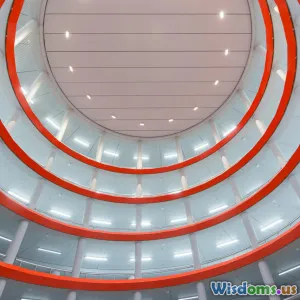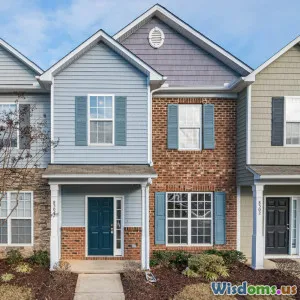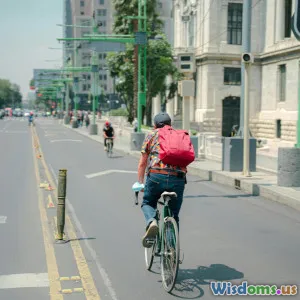
10 Creative Approaches to Make Cities More Livable for Everyone
10 min read Explore innovative strategies transforming urban life to create inclusive, sustainable, and vibrant cities for all residents. (0 Reviews)
10 Creative Approaches to Make Cities More Livable for Everyone
Cities around the world are hubs of culture, commerce, and innovation. Yet, as urban populations surge—expected to reach 68% of the global population by 2050 according to the UN—challenges like congestion, pollution, and inequality threaten quality of life. How can we design and adapt cities so they truly work for everyone?
This article dives deep into ten forward-thinking strategies from cities pioneering livability improvements. These creative approaches address everything from enhancing green spaces to redesigning transportation networks and promoting inclusivity. By exploring tangible examples and expert insights, readers will discover new perspectives that can inspire collective urban transformation.
1. Integrating Nature with Urban Design: Green Infrastructure
Nature-based solutions are revolutionizing urban planning by incorporating parks, green roofs, and urban forests into cityscapes. Green infrastructure not only beautifies cities but offers tangible environmental and social benefits.
For instance, Singapore’s iconic Gardens by the Bay features towering supertrees—vertical gardens with photovoltaic cells that generate solar energy. This project exemplifies balancing urban growth with biodiversity, providing cooling effects that mitigate heat islands prevalent in dense metropolises.
Studies show that residents with easy access to green spaces experience lower stress levels, better mental health, and increased physical activity. A 2018 review in The Lancet Planetary Health linked urban greenery with reduced cardiovascular and respiratory illnesses, emphasizing its critical role in public health.
2. Prioritizing Pedestrian and Cyclist-Friendly Infrastructure
Many cities have historically prioritized cars, contributing to traffic congestion, pollution, and community fragmentation. Shifting this paradigm starts with designing streetscapes that put pedestrians and cyclists first.
Copenhagen is often hailed for its extensive cycling infrastructure, where over 62% of residents commute daily by bike. Its network of separated bike lanes, synchronized traffic signals, and safe crossings demonstrate that urban cycling can be both practical and appealing.
Similarly, Barcelona’s “Superblocks” project creates designated areas by restricting vehicular traffic, reclaiming streets for pedestrians, social spaces, and green zones. Since implementation, air pollution levels dropped nearly 20% in these zones, with the bonus of reduced noise.
Such approaches foster social cohesiveness and help meet climate goals by lowering carbon footprints.
3. Affordable and Mixed-Income Housing Initiatives
Housing affordability remains one of the critical concerns in cities worldwide. Unchecked real estate inflation marginalizes low- and middle-income populations, resulting in displacement and homelessness.
Vienna’s successful social housing model allocates roughly 60% of residential units as affordable or subsidized housing. This system prevents socio-economic segregation and maintains vibrant, diverse neighborhoods. The city’s long-term investment underscores that equitable housing isn’t just ethical—it’s smart urban policy.
In the United States, Minneapolis abolished single-family zoning to encourage mixed-use, higher-density developments, thereby enhancing housing options without sprawling suburbs.
Crafting inclusive housing policies is vital to making cities livable for everyone.
4. Leveraging Smart Technologies to Enhance Urban Services
The rise of smart city technologies enables efficient resource management and better citizen engagement. From intelligent traffic management to adaptive lighting, technology can improve daily urban experiences.
Barcelona’s smart streetlights automatically adjust brightness based on pedestrian movement, lowering energy consumption by 30%. Sensors monitor environmental metrics like air quality and noise pollution, assisting authorities in responsive policymaking.
Equally important is ensuring equitable access to these technologies. Digital inclusion programs—such as free public Wi-Fi and digital literacy education—help bridge the digital divide, particularly benefiting marginalized communities.
5. Participatory Urban Planning and Community Engagement
Cities flourish when residents have a voice in how their neighborhoods evolve. Participatory urban planning fosters transparency, accountability, and inclusiveness.
Porto Alegre, Brazil pioneered participatory budgeting, allowing citizens to decide a portion of municipal spending. This citizen-centric approach improves fiscal transparency and aligns investments with community priorities.
New York City’s “PlaNYC” initiative incorporates extensive public feedback to guide sustainability goals. When people feel ownership over their surroundings, social capital and trust increase, foundational for resilient cities.
6. Enhancing Public Transit with Multimodal Connectivity
Reliable and accessible public transit is a cornerstone of livable cities. Multimodal networks combining buses, trams, subways, bike-sharing, and pedestrian paths create seamless mobility options.
Tokyo’s extensive rail network accommodates 9 million commuters daily with punctuality and safety, significantly reducing reliance on private cars. Complementary bicycle parking facilities and pedestrian plazas promote first- and last-mile connectivity.
Investment in transit-oriented development (TOD) around stations encourages compact, walkable neighborhoods that reduce urban sprawl and carbon emissions.
7. Designing Inclusive Public Spaces for Social Interaction
Public spaces are the heartbeats of urban life—places where diverse populations interact and build community.
New York’s High Line transformed a disused elevated railway into a vibrant linear park attracting millions annually. Its design prioritizes accessibility with ramps and seating, ensuring usability for children, seniors, and individuals with disabilities.
Multicultural programming and community gardens further nurture a sense of belonging. Inclusive design principles consider gender, age, and cultural diversity, enabling equitable participation.
8. Promoting Sustainable Urban Food Systems
Local food access strongly influences health outcomes and urban sustainability. Incorporating urban agriculture—such as rooftop farms, community gardens, and agripreneurship—strengthens food security.
Detroit’s urban farming movement leverages vacant lots to grow fresh produce, transforming struggling neighborhoods and reducing “food deserts.” According to a 2019 Urban Studies journal, such initiatives empower residents economically and nutritionally.
Cities can also encourage farmers’ markets, food cooperatives, and innovative technologies like vertical farming to boost local consumption.
9. Adapting to Climate Change with Resilience Planning
Climate change impacts cities severely through heatwaves, flooding, and storms. Resilient urban design minimizes vulnerability and safeguards populations.
New Orleans has invested billions in flood defense infrastructure post-Hurricane Katrina, addressing levee weaknesses and restoring wetlands. Equally, Rotterdam designed water plazas that double as recreational areas and rainwater retention basins, harmonizing infrastructure with community needs.
Embedding resilience strategies into zoning codes and building practices will be essential across urban areas worldwide.
10. Cultivating Cultural Vibrancy and Creativity
A city’s livability is enhanced by its cultural richness and opportunities for creative expression.
Melbourne’s laneways are internationally recognized for vibrant street art, cafés, and performance spaces that attract locals and tourists alike. These pockets of creativity generate economic growth while fostering cross-cultural dialogue.
Supporting local artists through grants, affordable studio spaces, and inclusive festivals nurtures community identity and mental well-being.
Conclusion
Building cities that are genuinely livable for everyone requires a multifaceted, inclusive approach. The examples above reveal that integrating nature, rethinking mobility, ensuring affordable housing, embracing technology, empowering communities, enhancing public transit, designing welcoming spaces, supporting food security, planning for climate resilience, and celebrating culture are all pivotal.
Urban planners, policymakers, and residents must collaborate to tailor these strategies to local contexts, recognizing that global challenges demand innovative, adaptable solutions. Ultimately, livability is not a luxury but a necessity—creating thriving, equitable cities benefits all, now and for generations to come.
“Cities have the capability of providing something for everybody, only because, and only when, they are created by everybody.” — Jane Jacobs
Rate the Post
User Reviews
Popular Posts


















